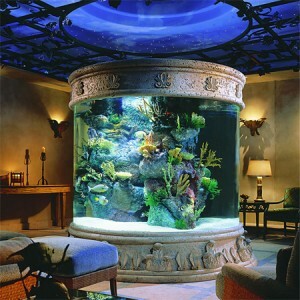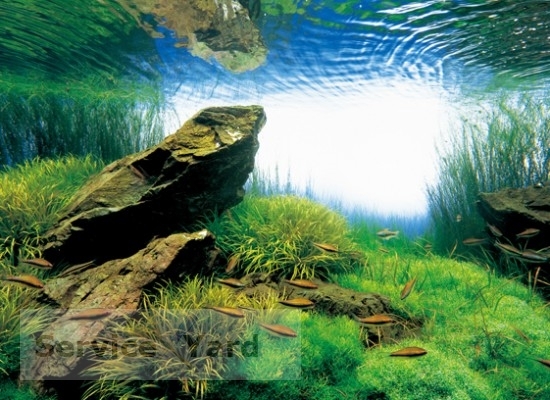
- How often should I clean the aquarium and why?
- Than to clean an aquarium?
- How to clean the aquarium properly?
- How to wash an aquarium with salt water?
- What else should I clean in the aquarium?
- Useful tips
Aquarium - always beautiful and useful: water and fish in it soothe the nervous system, evaporation moistens the air, but only if the contents are clean. Therefore, to know how to clean the aquarium is necessary for all who decided to acquire such a decor in their home.
to the contents ↑How often should I clean the aquarium and why?
 Care for the aquarium should be appropriate, as it inhabits living organisms and all the time there are some biochemical processes. The frequency of cleaning in it depends on the size and number of fish living in it. So, large ones can be cleaned once a month, and small ones are much more often, at the first necessity.
Care for the aquarium should be appropriate, as it inhabits living organisms and all the time there are some biochemical processes. The frequency of cleaning in it depends on the size and number of fish living in it. So, large ones can be cleaned once a month, and small ones are much more often, at the first necessity.
How to clean the aquarium?
First, prepare all the necessary tools for this case. You will need:
- large bucket;
- prepared water in the right amount for your aquarium;
- pump;
- thermometer;
- scraper for vegetation;
- hygrometer;
- filter accessories;
- cleaner for cleaning aquarium glass;
- pH measuring device.
How to clean the aquarium properly?
After you have prepared everything you need, get to work. Do it consistently in several stages.
Stage 1
To begin with, clean the walls of the aquarium from algae, after removing all the fish with a net and placing them in a container with suitable water. To do this:
- Take the scraper.
- Clean the walls of the aquarium.
- In case the scraper can not cope, use a conventional blade.
Note: Do not use a sponge or scraper from the kitchen, as these may contain detergent chemicals that are harmful to fish.
Step 2
In order to pump out the required amount of water, use the pump:
- Take the pump for pumping water.
- Dip one end into the aquarium water, the other end into an empty bucket.
- Pump the water.
Note: in aquariums, water must be changed at least once a week. In this case, it is enough to update 15% of water in order to get rid of the formed nitrates. If you have not changed the water for a long time, then it is worth changing 50% of the water or even completely renew it.
Stage 3
All garbage and waste products tend to settle down. Therefore, it is very important to clean the bottom in the aquarium once a week. To do this:
- Take the pump.
- Draw the suction part along the gravel.
- Clean from contamination.
Note: if you have small fish and you did not remove them from the aquarium before cleaning, put a kapron stocking on the sucking part, but the net of the stocking should be large enough for rubbish. If you do not have gravel and sand, keep the working part 3 cm from the surface.
Stage 4
If you have aquarium decorations, then you probably noticed that they, too, need care. To properly clean them from dirt, you can use a toothbrush and old aquarium water. But, if this is not enough, use this instruction:
- Get the jewelry.
- Prepare the solution from water and bleach.
- Put the objects in the solution.
- Leave for 20 minutes.
- Then put them in boiling water for 5 minutes.
- Remove, wait until dry.
- Place it back in the aquarium.
Note: if your decorations are quickly covered with bloom, you should not feed the fish or change the water more often.
Stage 5
Very often, when the water evaporates, it leaves behind a raid. You can get rid of it with the help of a scraper for algae. When you remove it, it's time to add fresh water. To do this, you first need to prepare it:
- Pour water into the bucket.
- Add 50% of distilled water.
- Leave to stand for a day.
- At the end of the period, check all the required parameters - the temperature should not be more than 28 degrees.
- It is now possible, with good performance, to add water. Do this with a pump, neatly and slowly.
- Do not pour water to the brim, between the lid of the aquarium and the water should be a space where oxygen will circulate.
Note: Try to measure the water temperature every day, as it is very important for a full life of fish. If, with partial replacement of water, it remains cloudy, then some problem remained unsolved. So it's worth replacing all the water.
Step 6
When all internal components of the aquarium are washed, the necessary parts have been replaced, all external parts should be wiped: glass, cover, lamp. To do this, use a special detergent for aquariums or simple vinegar:
- Apply a little to a clean, dry rag.
- Wipe surfaces.
- Wipe with a dry rag.
How to wash an aquarium with salt water?
 Many hold houses of fish, which can live only in salt water. To clean such an aquarium, the same manipulations remain, as for an aquarium with fresh water. The difference is only in the preparation of water. To do this, follow these instructions:
Many hold houses of fish, which can live only in salt water. To clean such an aquarium, the same manipulations remain, as for an aquarium with fresh water. The difference is only in the preparation of water. To do this, follow these instructions:
- Pour distilled water into the bucket.
- Add the required amount of special salt.
- Leave to stand overnight.
- In the morning check all the required parameters:
- temperature - it should not be more than 27 degrees;
- salt - its quantity should not exceed the norm indicated on the package.
What else should I clean in the aquarium?
A good filter plays a big role for the aquarium. It allows him to stay clean and comfortable for your pets. From time to time, the filter should also be put in order: wash it and replace the cartridges.
In order to properly clean the machine, follow these instructions:
- Remove the filter.
- Remove the foam insert from it.
- Wash it with running water.
- Take the toothbrush.
- Clean the remaining parts with it.
- Rinse under running water.
- Assemble.
- Place it back in the aquarium.
Note: do not use any detergents! Completely wash them off you can not, and the chemistry is very harmful to any fish.
to the table of contents ↑Useful advices for
There are also so-called nursing fishes that not only please the eye, but also benefit. These fish have an unusual structure of the mouth, which allows them to remove plaque from the walls of the aquarium, clean the bottom and plants from mold. Be sure to add these fish to your aquarium:
- guppy;
- swordsmen;
- armor catfish;
- ancistrus;
- pecilia;
- Mollies.
Use our recommendations, regularly clean the aquarium, and you will be happy with the activity of your pets and the attractiveness of such an interesting detail of the interior!



